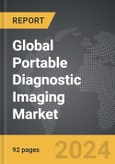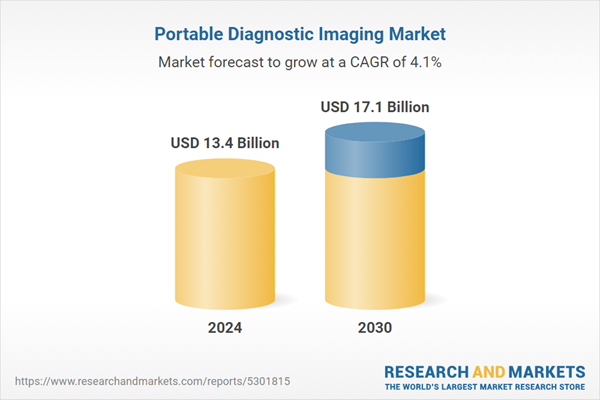Global Portable Diagnostic Imaging Market - Key Trends and Drivers Summarized
What Is Portable Diagnostic Imaging and Why Is It Transforming Healthcare?
Portable diagnostic imaging refers to medical imaging technologies that are compact, mobile, and designed for use at the point of care, whether in hospitals, clinics, or even at patients' homes. This technology includes devices such as portable ultrasound machines, X-ray systems, CT scanners, and MRI machines, which allow healthcare providers to capture images of the body's internal structures without requiring patients to be transported to a radiology department. Unlike traditional, large, stationary diagnostic imaging systems, portable devices are lightweight, battery-powered, and often come with wireless capabilities, making them ideal for emergency situations, rural healthcare, home healthcare, and in settings where quick diagnosis is critical. Portable diagnostic imaging has revolutionized the way healthcare is delivered, allowing for faster diagnoses, reducing the need for patient transfers, and improving the overall efficiency of medical care. In emergency medicine, for example, portable imaging can provide life-saving information in a matter of minutes, helping clinicians make critical decisions about treatment and interventions. This technology is particularly transformative in remote or underserved regions where access to full-scale imaging equipment is limited, providing these populations with vital diagnostic services that would otherwise be unavailable.How Have Technological Advancements Enhanced Portable Diagnostic Imaging?
Technological advancements have significantly improved the quality, portability, and functionality of diagnostic imaging devices, making them more powerful, accessible, and user-friendly. One of the most important innovations in this field is the miniaturization of imaging components, which has allowed manufacturers to create smaller, lighter, and more energy-efficient devices without sacrificing image quality. For example, portable ultrasound machines have advanced from large, cumbersome devices to compact, hand-held systems that can deliver high-resolution images. These devices often come with touchscreen interfaces, making them easier to use for healthcare providers in fast-paced environments such as emergency rooms or remote clinics. Another major leap in portable diagnostic imaging is the integration of wireless and cloud-based technologies. Modern portable imaging devices often feature wireless data transmission, enabling real-time image sharing with specialists and other healthcare professionals for remote consultations and second opinions. Artificial intelligence (AI) and machine learning algorithms have also been incorporated into some portable imaging systems, offering automated image analysis and diagnostic support, which can help detect abnormalities more quickly and accurately. These technological advancements not only enhance the diagnostic capabilities of portable imaging devices but also improve the speed and accessibility of care, particularly in time-sensitive situations.What Are the Key Applications of Portable Diagnostic Imaging, and Who Benefits Most from Its Use?
Portable diagnostic imaging is widely used in a variety of healthcare settings, providing benefits to multiple patient populations and healthcare providers. In emergency care, portable imaging devices play a critical role in trauma cases where rapid assessment is necessary to identify internal injuries, fractures, or bleeding. Portable X-ray machines, for instance, are often used at the patient's bedside in the ER or ICU to assess fractures, chest infections, or complications without needing to move the patient, which can be especially important for those in critical condition. The use of portable ultrasound is also common in emergency settings, helping physicians quickly assess conditions such as internal bleeding, heart function, or fluid buildup in the lungs. In rural and remote healthcare, where access to full-size imaging machines is limited, portable diagnostic imaging offers a lifeline for patients. Portable imaging is also increasingly used in home healthcare, particularly for elderly or immobile patients. Instead of transporting patients to a hospital for imaging, healthcare professionals can now perform diagnostic imaging in the patient's home, improving comfort and reducing stress for those with limited mobility. Additionally, portable diagnostic imaging has applications in specialized fields such as prenatal care, where portable ultrasound machines allow obstetricians and midwives to monitor fetal development without requiring a hospital visit. In sports medicine, portable devices are used to quickly diagnose injuries on the field, enabling immediate care and reducing recovery times. Military medicine is another sector that has adopted portable imaging, where battlefield medics use these devices to diagnose and triage injured soldiers in remote or combat zones.What's Driving the Growth of the Portable Diagnostic Imaging Market?
The growth in the portable diagnostic imaging market is driven by several key factors, each reflecting shifts in healthcare delivery, technological advancements, and increasing demand for accessible, efficient medical care. One of the primary drivers is the rising demand for point-of-care diagnostics, as healthcare providers and patients alike seek faster, more convenient solutions that eliminate the need for complex logistics associated with traditional imaging systems. The convenience and flexibility of portable diagnostic imaging are particularly appealing in emergency and critical care settings, where time is of the essence. The ongoing emphasis on improving healthcare access in rural and underserved regions is also fueling demand. Technological advancements have played a significant role in the market's expansion, particularly the miniaturization of components and the integration of wireless technologies, which have made portable devices more powerful and easier to use. Innovations in digital imaging and AI-driven image analysis are further enhancing the diagnostic capabilities of these devices, making them increasingly competitive with traditional, full-size systems. The growing trend of home healthcare is another critical factor driving growth, as the aging population and increasing prevalence of chronic diseases are creating a demand for in-home medical services. Moreover, the cost-effectiveness of portable diagnostic imaging is contributing to its adoption across healthcare sectors. Hospitals and clinics are recognizing that portable devices reduce the need for expensive infrastructure, such as large radiology departments, while also improving patient throughput and reducing wait times. This economic advantage is particularly relevant in developing markets, where healthcare providers are looking for affordable yet advanced solutions to meet growing demand. Lastly, the expansion of telemedicine and remote healthcare services has also accelerated the market's growth, as portable imaging devices enable healthcare providers to offer diagnostics and consultations remotely, increasing access to care while minimizing physical interactions - an especially important consideration in the post-pandemic world. These factors, combined with continuous innovations in imaging technology, are expected to sustain the rapid growth of the portable diagnostic imaging market for years to come.Report Scope
The report analyzes the Portable Diagnostic Imaging market, presented in terms of market value (US$ Thousand). The analysis covers the key segments and geographic regions outlined below.- Segments: Application (Cardiology, Gastrointestinal, Neurology, Respiratory, Gynecology, Urology, Orthopedics, Other Applications).
- Geographic Regions/Countries:World; United States; Canada; Japan; China; Europe (France; Germany; Italy; United Kingdom; Spain; Russia; and Rest of Europe); Asia-Pacific (Australia; India; South Korea; and Rest of Asia-Pacific); Latin America (Argentina; Brazil; Mexico; and Rest of Latin America); Middle East (Iran; Israel; Saudi Arabia; United Arab Emirates; and Rest of Middle East); and Africa.
Key Insights:
- Market Growth: Understand the significant growth trajectory of the Cardiology Application segment, which is expected to reach US$4.3 Billion by 2030 with a CAGR of a 4.3%. The Gastrointestinal Application segment is also set to grow at 5.2% CAGR over the analysis period.
- Regional Analysis: Gain insights into the U.S. market, valued at $3.6 Billion in 2024, and China, forecasted to grow at an impressive 7% CAGR to reach $3.6 Billion by 2030. Discover growth trends in other key regions, including Japan, Canada, Germany, and the Asia-Pacific.
Why You Should Buy This Report:
- Detailed Market Analysis: Access a thorough analysis of the Global Portable Diagnostic Imaging Market, covering all major geographic regions and market segments.
- Competitive Insights: Get an overview of the competitive landscape, including the market presence of major players across different geographies.
- Future Trends and Drivers: Understand the key trends and drivers shaping the future of the Global Portable Diagnostic Imaging Market.
- Actionable Insights: Benefit from actionable insights that can help you identify new revenue opportunities and make strategic business decisions.
Key Questions Answered:
- How is the Global Portable Diagnostic Imaging Market expected to evolve by 2030?
- What are the main drivers and restraints affecting the market?
- Which market segments will grow the most over the forecast period?
- How will market shares for different regions and segments change by 2030?
- Who are the leading players in the market, and what are their prospects?
Report Features:
- Comprehensive Market Data: Independent analysis of annual sales and market forecasts in US$ Million from 2024 to 2030.
- In-Depth Regional Analysis: Detailed insights into key markets, including the U.S., China, Japan, Canada, Europe, Asia-Pacific, Latin America, Middle East, and Africa.
- Company Profiles: Coverage of players such as Agfa-Gevaert N.V., Canon Inc., Carestream Health, CurveBeam LLC, Esaote SPA and more.
- Complimentary Updates: Receive free report updates for one year to keep you informed of the latest market developments.
Some of the 36 companies featured in this Portable Diagnostic Imaging market report include:
- Agfa-Gevaert N.V.
- Canon Inc.
- Carestream Health
- CurveBeam LLC
- Esaote SPA
- FUJIFILM Holdings Corporation
- GE Healthcare (General Electric Company)
- Hitachi, Ltd.
- Hologic, Inc.
- Koninklijke Philips N.V.
This edition integrates the latest global trade and economic shifts into comprehensive market analysis. Key updates include:
- Tariff and Trade Impact: Insights into global tariff negotiations across 180+ countries, with analysis of supply chain turbulence, sourcing disruptions, and geographic realignment. Special focus on 2025 as a pivotal year for trade tensions, including updated perspectives on the Trump-era tariffs.
- Adjusted Forecasts and Analytics: Revised global and regional market forecasts through 2030, incorporating tariff effects, economic uncertainty, and structural changes in globalization. Includes historical analysis from 2015 to 2023.
- Strategic Market Dynamics: Evaluation of revised market prospects, regional outlooks, and key economic indicators such as population and urbanization trends.
- Innovation & Technology Trends: Latest developments in product and process innovation, emerging technologies, and key industry drivers shaping the competitive landscape.
- Competitive Intelligence: Updated global market share estimates for 2025, competitive positioning of major players (Strong/Active/Niche/Trivial), and refined focus on leading global brands and core players.
- Expert Insight & Commentary: Strategic analysis from economists, trade experts, and domain specialists to contextualize market shifts and identify emerging opportunities.
Table of Contents
Companies Mentioned (Partial List)
A selection of companies mentioned in this report includes, but is not limited to:
- Agfa–Gevaert N.V.
- Canon Inc.
- Carestream Health
- CurveBeam LLC
- Esaote SPA
- FUJIFILM Holdings Corporation
- GE Healthcare (General Electric Company)
- Hitachi, Ltd.
- Hologic, Inc.
- Koninklijke Philips N.V.
Table Information
| Report Attribute | Details |
|---|---|
| No. of Pages | 192 |
| Published | December 2025 |
| Forecast Period | 2024 - 2030 |
| Estimated Market Value ( USD | $ 13.4 Billion |
| Forecasted Market Value ( USD | $ 17.1 Billion |
| Compound Annual Growth Rate | 4.1% |
| Regions Covered | Global |









